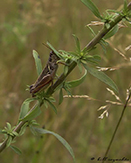Minnesota Grasshoppers, Crickets, and Katydids
Orthoptera (grasshoppers, crickets, and katydids) is the order of insects that is characterized by having long hind legs, modified for jumping; leathery forewings; unsegmented cerci (appendages at tip of abdomen); small and well separated hind coxae; a pronotum with large descending lateral lobes; hind tibiae with two dorsal rows of teeth; and nymphal wing rudiments reversing their orientation in later instars. The order includes grasshoppers, locusts, crickets, and katydids.
There are about 20,000 species worldwide, 1,200 species in about 256 genera in North America north of Mexico.

Recent Additions

Roesel’s katydid (Roeseliana roeselii) is a small, short-winged, shield-backed katydid. It is native to Europe, where it is called Roesel’s bush-cricket. In 1953 it was reported at two locations in Quebec. These were the first North American records. It has spread and now occurs in Canada from Prince Edward Island to Manitoba, and in the United States from Maine to Minnesota south to Maryland and Iowa. Adults are found from late June through October in meadows and grassy fields, at the margins of pastures, and in ditches and roadsides. They require a moist area with tall grasses that is undisturbed by mowing or grazing.
Adults are ½″ to 1″ in length and usually dark brown, sometimes yellow, rarely green. The plate covering the first segment of the thorax is brown on top, black on the sides, and cream-colored around the margins of each side. There are three pale green or yellow spots on each side of the thorax. Most adults have short wings and cannot fly. In most years, only about 1% have long functional wings. In years with exceptionally hot summers there are more winged adults.

Sword-bearing conehead (Neoconocephalus ensiger) is a common, large, meadow katydid. It is often heard at night but seldom seen in daylight. During the day it perches head down on the lower stalk of vegetation with only its wings and hind legs visible, appearing like a grass blade. At night the female can be found near a calling male feeding on the seed head of a grass plant.
Sword-bearing conehead has two color phases, leaf green and dark tan. It is most easily identified by the song of the male. The male has sound-producing organs, a “scraper” at the anal edge of the right front wing and a “file” near the base of the left front wing. By rubbing the file against the scraper the male produces a distinctive song. It is a continuous series of high-pitched lisps, clearly separated, produced at the rate of 10 per second. It is often compared to the sound of a distant locomotive.
Aside from its song, sword-bearing conehead is identified by the long wings and antennae; the rounded “cone” at the top of the head that is separated from the head by a gap; the narrow yellowish edging on the thorax and the front wing; and the curved, sword-like ovipositor on the female.

Migratory grasshopper (Melanoplus sanguinipes) is a common, medium-sized, spur-throated, short-horned grasshopper. It may be the most common species of grasshopper in North American grasslands. It is common in Minnesota. It is found in a wide variety of habitats, including prairies, meadows, pastures, abandoned fields, woodland openings, and roadsides.
It is a serious agricultural pest, causing more crop damage than any other species of grasshopper in North America. As its common name implies, the migratory grasshopper congregates into swarms and migrates in search of food. When they do they may devastate all leafy vegetation wherever they land. Swarms have been detected at all elevations up to 13,000 feet and have been recorded traveling as much as 575 miles.
The family short-horned grasshoppers have antennae no more than half the length of the body, upper thoracic plate (pronotum) not extending over the abdomen, well developed wings, and a three segmented foot. The subfamily spur-throated grasshoppers have a tiny bump on their “throat”; a flat, rounded pronotum; a vertical face; and clear hindwings. Migratory grasshoppers are identified by hind wings that are longer than the body; front wings that are about as long as the body and are mostly transparent but have dark spots; a pale yellow stripe behind the eye; a banded hind femur; and features at the tip of the abdomen visible only in an extreme close-up photo.
_01it.jpg)
This is a very common genus of native crickets. It can be found under rotten logs, under stones, in mole hills, and other moist dark places, but is most often encountered in basements. Unlike most crickets it has no hearing organs (tympanum).
The family (Rhaphidophoridae) is identified by its distinctive, hump-backed shape, lack of wings and tympanum, and antennae longer than the body. The genus (Ceuthophilus) is identified by four end segments (tarsi) on each leg and the lack of a spine on the front of the tibia of the foreleg.
Other Recent Additions
This list includes only grasshoppers, crickets, and katydids that have been recorded in Minnesota, but not all of the grasshoppers, crickets, and katydids found in Minnesota.
| Profile | Photo | Video | Audio | |||
|---|---|---|---|---|---|---|
admirable grasshopper (Syrbula admirabilis) |
|
|||||
American bird grasshopper (Schistocerca americana) |
||||||
autumn yellow-winged grasshopper (Arphia xanthoptera) |
||||||
big-headed grasshopper (Aulocara elliotti) |
||||||
black-legged meadow katydid (Orchelimum nigripes) |
||||||
blue-legged grasshopper (Metator pardalinus) |
||||||
broad-winged bush katydid (Scudderia pistillata) |
||||||
Bruner’s spur-throat grasshopper (Melanoplus bruneri) |
||||||
clear-winged grasshopper (Camnula pellucida) |
||||||
clip-wing grasshopper (Metaleptea brevicornis) |
||||||
clouded grasshopper (Encoptolophus sordidus) |
||||||
club-horned grasshopper (Aeropedellus clavatus) |
||||||
common meadow katydid (Orchelimum vulgare) |
||||||
common true katydid (Pterophylla camellifolia) |
||||||
crackling forest grasshopper (Trimerotropis verruculata) |
||||||
Dawson’s grasshopper (Melanoplus dawsoni) |
||||||
flabellate grasshopper (Melanoplus occidentalis) |
||||||
four-spotted grasshopper (Phlibostroma quadrimaculata) |
||||||
Geyser grasshopper (Trimerotropis diversellus) |
||||||
gladiator meadow katydid (Orchelimum gladiator) |
||||||
Gladston’s grasshopper (Melanoplus gladstoni) |
||||||
graceful sedge grasshopper (Stethophyma gracilis) |
||||||
greater angle-wing (Microcentrum rhombifolium) |
||||||
green-legged grasshoppers (Melanoplus viridipes-species-group) |
||||||
Haldeman’s grasshopper (Pardalophora haldemanii) |
||||||
huckleberry grasshopper (Melanoplus fasciatus) |
||||||
Huron short-wing grasshopper (Melanoplus huroni) |
||||||
Keeler’s grasshopper (Melanoplus keeleri luridus) |
||||||
Kiowa grasshopper (Trachyrhachys kiowa) |
||||||
large-headed grasshopper (Phoetaliotes nebrascensis) |
||||||
leather-colored bird grasshopper (Schistocerca alutacea) |
||||||
little spur-throat grasshopper (Melanoplus infantilis) |
||||||
long-spurred meadow katydid (Orchelimum silvaticum) |
||||||
longhorn band-wing grasshopper (Psinidia fenestralis) |
||||||
mottled sand grasshopper (Spharagemon collare) |
||||||
mugwort grasshopper (Hypochlora alba) |
||||||
narrow-winged sand grasshopper (Melanoplus angustipennis) |
||||||
narrow-winged tree cricket (Oecanthus niveus) |
||||||
northern grasshopper (Melanoplus borealis) |
||||||
northern marbled grasshopper (Spharagemon marmoratum marmoratum) |
||||||
obscure grasshopper (Opeia obscura) |
||||||
orange-winged grasshopper (Pardalophora phoenicoptera) |
||||||
Packard's grasshopper (Melanoplus packardii) |
||||||
pasture grasshopper (Melanoplus confusus) |
||||||
pine tree spur-throat grasshopper (Melanoplus punctulatus) |
||||||
post oak grasshopper (Dendrotettix quercus) |
||||||
protean shieldback (Atlanticus testaceus) |
||||||
purple-striped grasshopper (Hesperotettix viridis pratensis) |
||||||
red-shanked grasshopper (Xanthippus corallipes latifasciatus) |
||||||
red-winged grasshopper (Arphia pseudonietana) |
||||||
robust conehead (Neoconocephalus robustus) |
||||||
Rocky Mountain sprinkled locust (Chloealtis abdominalis) |
||||||
round-headed katydid (Amblycorypha spp.) |
||||||
seaside grasshopper (Trimerotropis maritima) |
||||||
short-winged green grasshopper (Dichromorpha viridis) |
||||||
short-winged toothpick grasshopper (Pseudopomala brachyptera) |
||||||
showy grasshopper (Hesperotettix speciosus) |
||||||
slant-faced pasture grasshopper (Orphulella speciosa) |
||||||
slender meadow katydid (Conocephalus fasciatus) |
||||||
southern sedge grasshopper (Stethophyma celata) |
||||||
speckle-winged rangeland grasshopper (Arphia conspersa) |
||||||
spotted-winged grasshopper (Orphulella pelidna) |
||||||
spring field cricket (Gryllus veletis) |
||||||
sprinkled grasshopper (Chloealtis conspersa) |
||||||
Stone’s grasshopper (Melanoplus stonei) |
||||||
straight-lanced meadow katydid (Conocephalus strictus) |
||||||
striped sand grasshopper (Melanoplus foedus) |
||||||
striped sedge grasshopper (Stethophyma lineata) |
||||||
striped slant-face grasshopper (Amphitornus coloradus) |
||||||
Texas bush katydid (Scudderia texensis) |
||||||
two-spotted tree cricket (Neoxabea bipunctata) |
||||||
two-striped mermiria (Mermiria bivittata) |
||||||
velvet-striped grasshopper (Eritettix simplex) |
||||||
western clouded grasshopper (Encoptolophus costalis) |
||||||
white-whiskered grasshopper (Ageneotettix deorum) |
||||||
wingless mountain grasshopper (Booneacris glacialis) |
||||||
woodland meadow katydid (Conocephalus nemoralis) |
||||||
wrinkled grasshopper (Hippiscus ocelote) |
||||||
yellowish spur-throat grasshopper (Melanoplus flavidus) |
Acrididae (short-horned grasshoppers)
Aeropedellus clavatus (club-horned grasshopper)
Ageneotettix deorum (white-whiskered grasshopper)
Allonemobius allardi (Allard’s ground cricket)
Allonemobius fasciatus (striped ground cricket)
Amblycorypha oblongifolia (oblong-winged katydid)
Amblycorypha spp. (round-headed katydid)
Amphitornus coloradus (striped slant-face grasshopper)
Arphia conspersa (speckle-winged rangeland grasshopper)
Arphia pseudonietana (red-winged grasshopper)
Arphia sulphurea (sulphur-winged grasshopper)
Arphia xanthoptera (autumn yellow-winged grasshopper)
Atlanticus testaceus (protean shieldback)
Aulocara elliotti (big-headed grasshopper)
Booneacris glacialis (wingless mountain grasshopper)
Camnula pellucida (clear-winged grasshopper)
Ceuthophilus spp. (camel crickets)
Chloealtis abdominalis (Rocky Mountain sprinkled locust)
Chloealtis conspersa (sprinkled grasshopper)
Chortophaga viridifasciata (green-striped grasshopper)
Conocephalus brevipennis (short-winged meadow katydid)
Conocephalus fasciatus (slender meadow katydid)
Conocephalus nemoralis (woodland meadow katydid)
Conocephalus nigropleurum (black-sided meadow katydid)
Conocephalus strictus (straight-lanced meadow katydid)
Dendrotettix quercus (post oak grasshopper)
Dichromorpha viridis (short-winged green grasshopper)
Dissosteira carolina (Carolina grasshopper)
Encoptolophus costalis (western clouded grasshopper)
Encoptolophus sordidus (clouded grasshopper)
Eritettix simplex (velvet-striped grasshopper)
Gryllus pennsylvanicus (fall field cricket)
Gryllus veletis (spring field cricket)
Hesperotettix speciosus (showy grasshopper)
Hesperotettix viridis pratensis (purple-striped grasshopper)
Hippiscus ocelote (wrinkled grasshopper)
Hypochlora alba (mugwort grasshopper)
Melanoplus angustipennis (narrow-winged sand grasshopper)
Melanoplus bivittatus (two-striped grasshopper)
Melanoplus borealis (northern grasshopper)
Melanoplus bruneri (Bruner’s spur-throat grasshopper)
Melanoplus confusus (pasture grasshopper)
Melanoplus dawsoni (Dawson’s grasshopper)
Melanoplus differentialis (differential grasshopper)
Melanoplus fasciatus (huckleberry grasshopper)
Melanoplus femurrubrum (red-legged grasshopper)
Melanoplus flavidus (yellowish spur-throat grasshopper)
Melanoplus foedus (striped sand grasshopper)
Melanoplus gladstoni (Gladston’s grasshopper)
Melanoplus gracilis (graceful grasshopper)
Melanoplus huroni (Huron short-wing grasshopper)
Melanoplus infantilis (little spur-throat grasshopper)
Melanoplus islandicus (forest locust)
Melanoplus keeleri luridus (Keeler’s grasshopper)
Melanoplus occidentalis (flabellate grasshopper)
Melanoplus packardii (Packard's grasshopper)
Melanoplus punctulatus (pine tree spur-throat grasshopper)
Melanoplus sanguinipes (migratory grasshopper)
Melanoplus scudderi (Scudder’s short-wing grasshopper)
Melanoplus spp. (North American spur-throated grasshoppers)
Melanoplus stonei (Stone’s grasshopper)
Melanoplus viridipes-species-group (green-legged grasshopper)
Melanoplus walshii (Walsh’s locust)
Mermiria bivittata (two-striped mermiria)
Metaleptea brevicornis (clip-wing grasshopper)
Metator pardalinus (blue-legged grasshopper)
Microcentrum rhombifolium (greater angle-wing)
Neoconocephalus ensiger (sword-bearing conehead)
Neoconocephalus robustus (robust conehead)
Neoxabea bipunctata (two-spotted tree cricket)
Oecanthus forbesi (Forbes’ tree cricket)
Oecanthus fultoni (snowy tree cricket)
Oecanthus niveus (narrow-winged tree cricket)
Oecanthus pini (pine tree cricket)
Oecanthus quadripunctatus (four-spotted tree cricket)
Opeia obscura (obscure grasshopper)
Orchelimum gladiator (gladiator meadow katydid)
Orchelimum nigripes (black-legged meadow katydid)
Orchelimum silvaticum (long-spurred meadow katydid)
Orchelimum vulgare (common meadow katydid)
Orphulella pelidna (spotted-winged grasshopper)
Orphulella speciosa (slant-faced pasture grasshopper)
Pardalophora apiculata (coral-winged grasshopper)
Pardalophora haldemanii (Haldeman’s grasshopper)
Pardalophora phoenicoptera (orange-winged grasshopper)
Phlibostroma quadrimaculata (four-spotted grasshopper)
Phoetaliotes nebrascensis (large-headed grasshopper)
Pseudochorthippus curtipennis (marsh meadow grasshopper)
Pseudopomala brachyptera (short-winged toothpick grasshopper)
Psinidia fenestralis (longhorn band-wing grasshopper)
Pterophylla camellifolia (common true katydid)
Roeseliana roeselii (Roesel’s katydid)
Schistocerca alutacea (leather-colored bird grasshopper)
Schistocerca americana (American bird grasshopper)
Schistocerca lineata (spotted bird grasshopper)
Scudderia curvicauda (curve-tailed bush katydid)
Scudderia furcata (fork-tailed bush katydid)
Scudderia pistillata (broad-winged bush katydid)
Scudderia septentrionalis (northern bush katydid)
Scudderia spp. (Scudder’s bush katydid)
Scudderia texensis (Texas bush katydid)
Spharagemon collare (mottled sand grasshopper)
Spharagemon marmoratum marmoratum (northern marbled grasshopper)
Stethophyma celata (southern sedge grasshopper)
Stethophyma gracilis (graceful sedge grasshopper)
Stethophyma lineata (striped sedge grasshopper)
Syrbula admirabilis (admirable grasshopper)
Tetrix arenosa (obscure pygmy grasshopper)
Trachyrhachys kiowa (Kiowa grasshopper)
Trimerotropis diversellus (Geyser grasshopper)
Trimerotropis maritima (seaside grasshopper)
Trimerotropis verruculata (crackling forest grasshopper)
Xanthippus corallipes latifasciatus (red-shanked grasshopper)
No Species Page Yet?
If you do not see a linked page for a species in the list at left you can still upload a photo or video or report a sighting for that species. Click on one of the buttons below and type in the common name and/or scientific name of the species in your photo, video, or sighting. A new page will be created for that species featuring your contribution.
These buttons not working for you?
Simply email us at info@MinnesotaSeasons.com.







































